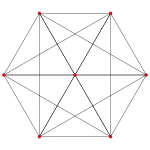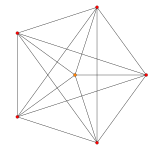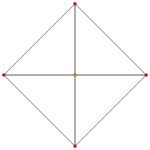6-simplex
| 6-simplex | |
|---|---|
| Type | uniform polypeton |
| Schläfli symbol | {35} |
| Coxeter diagrams | |
| Elements | f5 = 7, f4 = 21, C = 35, F = 35, E = 21, V = 7 |
| Coxeter group | A6, [35], order 5040 |
| Bowers name and (acronym) | Heptapeton (hop) |
| Vertex figure | 5-simplex |
| Circumradius | 0.645497 |
| Properties | convex, isogonal self-dual |
In geometry, a 6-simplex is a self-dual regular 6-polytope. It has 7 vertices, 21 edges, 35 triangle faces, 35 tetrahedral cells, 21 5-cell 4-faces, and 7 5-simplex 5-faces. Its dihedral angle is cos−1(1/6), or approximately 80.41°.
Contents
1 Alternate names
2 As a configuration
3 Coordinates
4 Images
5 Related uniform 6-polytopes
6 Notes
7 References
8 External links
Alternate names
It can also be called a heptapeton, or hepta-6-tope, as a 7-facetted polytope in 6-dimensions. The name heptapeton is derived from hepta for seven facets in Greek and -peta for having five-dimensional facets, and -on. Jonathan Bowers gives a heptapeton the acronym hop.[1]
As a configuration
This configuration matrix represents the 6-simplex. The rows and columns correspond to vertices, edges, faces, cells, 4-faces and 5-faces. The diagonal numbers say how many of each element occur in the whole 6-simplex. The nondiagonal numbers say how many of the column's element occur in or at the row's element. This self-dual simplex's matrix is identical to its 180 degree rotation.[2][3]
[76152015622151010533354644643533510105212615201567]{displaystyle {begin{bmatrix}{begin{matrix}7&6&15&20&15&6\2&21&5&10&10&5\3&3&35&4&6&4\4&6&4&35&3&3\5&10&10&5&21&2\6&15&20&15&6&7end{matrix}}end{bmatrix}}}
Coordinates
The Cartesian coordinates for an origin-centered regular heptapeton having edge length 2 are:
- (1/21, 1/15, 1/10, 1/6, 1/3, ±1){displaystyle left({sqrt {1/21}}, {sqrt {1/15}}, {sqrt {1/10}}, {sqrt {1/6}}, {sqrt {1/3}}, pm 1right)}
- (1/21, 1/15, 1/10, 1/6, −21/3, 0){displaystyle left({sqrt {1/21}}, {sqrt {1/15}}, {sqrt {1/10}}, {sqrt {1/6}}, -2{sqrt {1/3}}, 0right)}
- (1/21, 1/15, 1/10, −3/2, 0, 0){displaystyle left({sqrt {1/21}}, {sqrt {1/15}}, {sqrt {1/10}}, -{sqrt {3/2}}, 0, 0right)}
- (1/21, 1/15, −22/5, 0, 0, 0){displaystyle left({sqrt {1/21}}, {sqrt {1/15}}, -2{sqrt {2/5}}, 0, 0, 0right)}
- (1/21, −5/3, 0, 0, 0, 0){displaystyle left({sqrt {1/21}}, -{sqrt {5/3}}, 0, 0, 0, 0right)}
- (−12/7, 0, 0, 0, 0, 0){displaystyle left(-{sqrt {12/7}}, 0, 0, 0, 0, 0right)}
The vertices of the 6-simplex can be more simply positioned in 7-space as permutations of:
- (0,0,0,0,0,0,1)
This construction is based on facets of the 7-orthoplex.
Images
| AkCoxeter plane | A6 | A5 | A4 |
|---|---|---|---|
| Graph |  |  |  |
Dihedral symmetry | [7] | [6] | [5] |
| Ak Coxeter plane | A3 | A2 | |
| Graph |  |  | |
| Dihedral symmetry | [4] | [3] |
Related uniform 6-polytopes
The regular 6-simplex is one of 35 uniform 6-polytopes based on the [3,3,3,3,3] Coxeter group, all shown here in A6Coxeter plane orthographic projections.
| A6 polytopes | |||||||||||
|---|---|---|---|---|---|---|---|---|---|---|---|
 t0 |  t1 |  t2 |  t0,1 |  t0,2 |  t1,2 |  t0,3 |  t1,3 |  t2,3 | |||
 t0,4 |  t1,4 |  t0,5 |  t0,1,2 |  t0,1,3 |  t0,2,3 |  t1,2,3 |  t0,1,4 |  t0,2,4 | |||
 t1,2,4 |  t0,3,4 |  t0,1,5 |  t0,2,5 |  t0,1,2,3 |  t0,1,2,4 |  t0,1,3,4 |  t0,2,3,4 |  t1,2,3,4 | |||
 t0,1,2,5 |  t0,1,3,5 |  t0,2,3,5 |  t0,1,4,5 |  t0,1,2,3,4 |  t0,1,2,3,5 |  t0,1,2,4,5 |  t0,1,2,3,4,5 | ||||
Notes
^ Klitzing, (x3o3o3o3o3o - hop)
^ Coxeter, Regular Polytopes, sec 1.8 Configurations
^ Coxeter, Complex Regular Polytopes, p.117
References
H.S.M. Coxeter:
- Coxeter, Regular Polytopes, (3rd edition, 1973), Dover edition, .mw-parser-output cite.citation{font-style:inherit}.mw-parser-output .citation q{quotes:"""""""'""'"}.mw-parser-output .citation .cs1-lock-free a{background:url("//upload.wikimedia.org/wikipedia/commons/thumb/6/65/Lock-green.svg/9px-Lock-green.svg.png")no-repeat;background-position:right .1em center}.mw-parser-output .citation .cs1-lock-limited a,.mw-parser-output .citation .cs1-lock-registration a{background:url("//upload.wikimedia.org/wikipedia/commons/thumb/d/d6/Lock-gray-alt-2.svg/9px-Lock-gray-alt-2.svg.png")no-repeat;background-position:right .1em center}.mw-parser-output .citation .cs1-lock-subscription a{background:url("//upload.wikimedia.org/wikipedia/commons/thumb/a/aa/Lock-red-alt-2.svg/9px-Lock-red-alt-2.svg.png")no-repeat;background-position:right .1em center}.mw-parser-output .cs1-subscription,.mw-parser-output .cs1-registration{color:#555}.mw-parser-output .cs1-subscription span,.mw-parser-output .cs1-registration span{border-bottom:1px dotted;cursor:help}.mw-parser-output .cs1-ws-icon a{background:url("//upload.wikimedia.org/wikipedia/commons/thumb/4/4c/Wikisource-logo.svg/12px-Wikisource-logo.svg.png")no-repeat;background-position:right .1em center}.mw-parser-output code.cs1-code{color:inherit;background:inherit;border:inherit;padding:inherit}.mw-parser-output .cs1-hidden-error{display:none;font-size:100%}.mw-parser-output .cs1-visible-error{font-size:100%}.mw-parser-output .cs1-maint{display:none;color:#33aa33;margin-left:0.3em}.mw-parser-output .cs1-subscription,.mw-parser-output .cs1-registration,.mw-parser-output .cs1-format{font-size:95%}.mw-parser-output .cs1-kern-left,.mw-parser-output .cs1-kern-wl-left{padding-left:0.2em}.mw-parser-output .cs1-kern-right,.mw-parser-output .cs1-kern-wl-right{padding-right:0.2em}
ISBN 0-486-61480-8, p. 296, Table I (iii): Regular Polytopes, three regular polytopes in n-dimensions (n≥5) - H.S.M. Coxeter, Regular Polytopes, 3rd Edition, Dover New York, 1973, p. 296, Table I (iii): Regular Polytopes, three regular polytopes in n-dimensions (n≥5)
Kaleidoscopes: Selected Writings of H.S.M. Coxeter, edited by F. Arthur Sherk, Peter McMullen, Anthony C. Thompson, Asia Ivic Weiss, Wiley-Interscience Publication, 1995,
ISBN 978-0-471-01003-6 [1]
- (Paper 22) H.S.M. Coxeter, Regular and Semi Regular Polytopes I, [Math. Zeit. 46 (1940) 380-407, MR 2,10]
- (Paper 23) H.S.M. Coxeter, Regular and Semi-Regular Polytopes II, [Math. Zeit. 188 (1985) 559-591]
- (Paper 24) H.S.M. Coxeter, Regular and Semi-Regular Polytopes III, [Math. Zeit. 200 (1988) 3-45]
- Coxeter, Regular Polytopes, (3rd edition, 1973), Dover edition, .mw-parser-output cite.citation{font-style:inherit}.mw-parser-output .citation q{quotes:"""""""'""'"}.mw-parser-output .citation .cs1-lock-free a{background:url("//upload.wikimedia.org/wikipedia/commons/thumb/6/65/Lock-green.svg/9px-Lock-green.svg.png")no-repeat;background-position:right .1em center}.mw-parser-output .citation .cs1-lock-limited a,.mw-parser-output .citation .cs1-lock-registration a{background:url("//upload.wikimedia.org/wikipedia/commons/thumb/d/d6/Lock-gray-alt-2.svg/9px-Lock-gray-alt-2.svg.png")no-repeat;background-position:right .1em center}.mw-parser-output .citation .cs1-lock-subscription a{background:url("//upload.wikimedia.org/wikipedia/commons/thumb/a/aa/Lock-red-alt-2.svg/9px-Lock-red-alt-2.svg.png")no-repeat;background-position:right .1em center}.mw-parser-output .cs1-subscription,.mw-parser-output .cs1-registration{color:#555}.mw-parser-output .cs1-subscription span,.mw-parser-output .cs1-registration span{border-bottom:1px dotted;cursor:help}.mw-parser-output .cs1-ws-icon a{background:url("//upload.wikimedia.org/wikipedia/commons/thumb/4/4c/Wikisource-logo.svg/12px-Wikisource-logo.svg.png")no-repeat;background-position:right .1em center}.mw-parser-output code.cs1-code{color:inherit;background:inherit;border:inherit;padding:inherit}.mw-parser-output .cs1-hidden-error{display:none;font-size:100%}.mw-parser-output .cs1-visible-error{font-size:100%}.mw-parser-output .cs1-maint{display:none;color:#33aa33;margin-left:0.3em}.mw-parser-output .cs1-subscription,.mw-parser-output .cs1-registration,.mw-parser-output .cs1-format{font-size:95%}.mw-parser-output .cs1-kern-left,.mw-parser-output .cs1-kern-wl-left{padding-left:0.2em}.mw-parser-output .cs1-kern-right,.mw-parser-output .cs1-kern-wl-right{padding-right:0.2em}
John H. Conway, Heidi Burgiel, Chaim Goodman-Strass, The Symmetries of Things 2008,
ISBN 978-1-56881-220-5 (Chapter 26. pp. 409: Hemicubes: 1n1)
Norman Johnson Uniform Polytopes, Manuscript (1991)
- N.W. Johnson: The Theory of Uniform Polytopes and Honeycombs, Ph.D. (1966)
Klitzing, Richard. "6D uniform polytopes (polypeta) x3o3o3o3o - hix".
External links
Olshevsky, George. "Simplex". Glossary for Hyperspace. Archived from the original on 4 February 2007.
- Polytopes of Various Dimensions
- Multi-dimensional Glossary
Fundamental convex regular and uniform polytopes in dimensions 2–10 | ||||||||||||
|---|---|---|---|---|---|---|---|---|---|---|---|---|
Family | An | Bn | I2(p) / Dn | E6 / E7 / E8 / F4 / G2 | Hn | |||||||
Regular polygon | Triangle | Square | p-gon | Hexagon | Pentagon | |||||||
Uniform polyhedron | Tetrahedron | Octahedron • Cube | Demicube | Dodecahedron • Icosahedron | ||||||||
Uniform 4-polytope | 5-cell | 16-cell • Tesseract | Demitesseract | 24-cell | 120-cell • 600-cell | |||||||
Uniform 5-polytope | 5-simplex | 5-orthoplex • 5-cube | 5-demicube | |||||||||
Uniform 6-polytope | 6-simplex | 6-orthoplex • 6-cube | 6-demicube | 122 • 221 | ||||||||
Uniform 7-polytope | 7-simplex | 7-orthoplex • 7-cube | 7-demicube | 132 • 231 • 321 | ||||||||
Uniform 8-polytope | 8-simplex | 8-orthoplex • 8-cube | 8-demicube | 142 • 241 • 421 | ||||||||
Uniform 9-polytope | 9-simplex | 9-orthoplex • 9-cube | 9-demicube | |||||||||
Uniform 10-polytope | 10-simplex | 10-orthoplex • 10-cube | 10-demicube | |||||||||
| Uniform n-polytope | n-simplex | n-orthoplex • n-cube | n-demicube | 1k2 • 2k1 • k21 | n-pentagonal polytope | |||||||
| Topics: Polytope families • Regular polytope • List of regular polytopes and compounds | ||||||||||||






